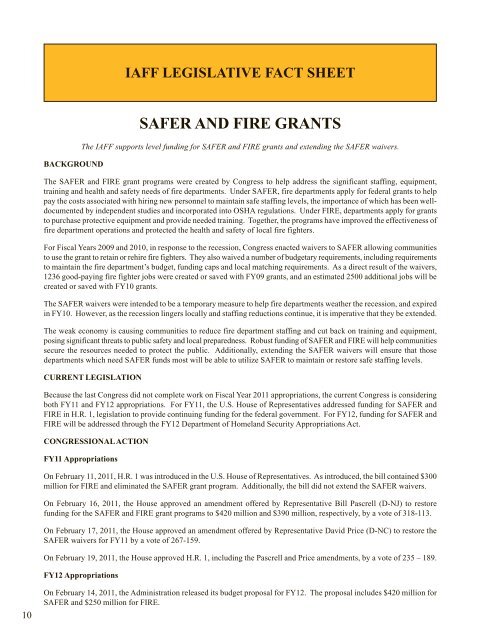2011 Fire Fighters Issues Book.pmd - IAFF
2011 Fire Fighters Issues Book.pmd - IAFF
2011 Fire Fighters Issues Book.pmd - IAFF
Create successful ePaper yourself
Turn your PDF publications into a flip-book with our unique Google optimized e-Paper software.
<strong>IAFF</strong> LEGISLATIVE FACT SHEET<br />
BACKGROUND<br />
SAFER AND FIRE GRANTS<br />
The <strong>IAFF</strong> supports level funding for SAFER and FIRE grants and extending the SAFER waivers.<br />
The SAFER and FIRE grant programs were created by Congress to help address the significant staffing, equipment,<br />
training and health and safety needs of fire departments. Under SAFER, fire departments apply for federal grants to help<br />
pay the costs associated with hiring new personnel to maintain safe staffing levels, the importance of which has been welldocumented<br />
by independent studies and incorporated into OSHA regulations. Under FIRE, departments apply for grants<br />
to purchase protective equipment and provide needed training. Together, the programs have improved the effectiveness of<br />
fire department operations and protected the health and safety of local fire fighters.<br />
For Fiscal Years 2009 and 2010, in response to the recession, Congress enacted waivers to SAFER allowing communities<br />
to use the grant to retain or rehire fire fighters. They also waived a number of budgetary requirements, including requirements<br />
to maintain the fire department’s budget, funding caps and local matching requirements. As a direct result of the waivers,<br />
1236 good-paying fire fighter jobs were created or saved with FY09 grants, and an estimated 2500 additional jobs will be<br />
created or saved with FY10 grants.<br />
The SAFER waivers were intended to be a temporary measure to help fire departments weather the recession, and expired<br />
in FY10. However, as the recession lingers locally and staffing reductions continue, it is imperative that they be extended.<br />
The weak economy is causing communities to reduce fire department staffing and cut back on training and equipment,<br />
posing significant threats to public safety and local preparedness. Robust funding of SAFER and FIRE will help communities<br />
secure the resources needed to protect the public. Additionally, extending the SAFER waivers will ensure that those<br />
departments which need SAFER funds most will be able to utilize SAFER to maintain or restore safe staffing levels.<br />
CURRENT LEGISLATION<br />
Because the last Congress did not complete work on Fiscal Year <strong>2011</strong> appropriations, the current Congress is considering<br />
both FY11 and FY12 appropriations. For FY11, the U.S. House of Representatives addressed funding for SAFER and<br />
FIRE in H.R. 1, legislation to provide continuing funding for the federal government. For FY12, funding for SAFER and<br />
FIRE will be addressed through the FY12 Department of Homeland Security Appropriations Act.<br />
CONGRESSIONAL ACTION<br />
FY11 Appropriations<br />
On February 11, <strong>2011</strong>, H.R. 1 was introduced in the U.S. House of Representatives. As introduced, the bill contained $300<br />
million for FIRE and eliminated the SAFER grant program. Additionally, the bill did not extend the SAFER waivers.<br />
On February 16, <strong>2011</strong>, the House approved an amendment offered by Representative Bill Pascrell (D-NJ) to restore<br />
funding for the SAFER and FIRE grant programs to $420 million and $390 million, respectively, by a vote of 318-113.<br />
On February 17, <strong>2011</strong>, the House approved an amendment offered by Representative David Price (D-NC) to restore the<br />
SAFER waivers for FY11 by a vote of 267-159.<br />
On February 19, <strong>2011</strong>, the House approved H.R. 1, including the Pascrell and Price amendments, by a vote of 235 – 189.<br />
FY12 Appropriations<br />
10<br />
On February 14, <strong>2011</strong>, the Administration released its budget proposal for FY12. The proposal includes $420 million for<br />
SAFER and $250 million for FIRE.

















